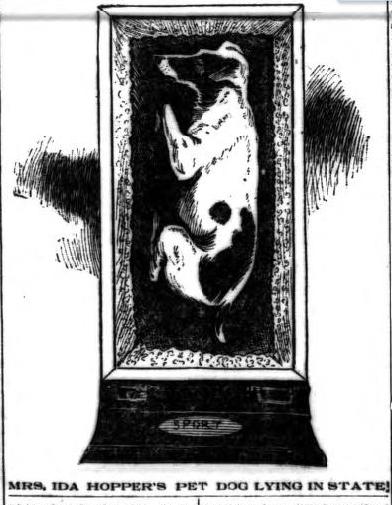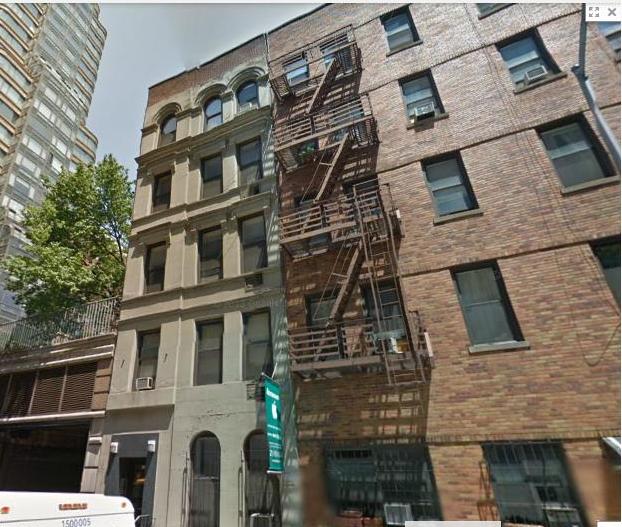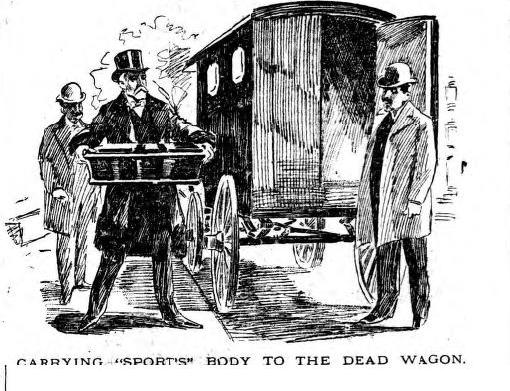
Sport Hopper changed history for thousands of New York pets…
Although it is illegal in New York to bury pets in human cemeteries, historically speaking, that’s a fairly new law. Up until 1949, pet owners could bury their furry companions in the family plot, provided the cemetery or other deed owners had no objections.
There are a few famous dogs buried in Brooklyn’s Green-Wood Cemetery, including Gypsie, the black and white Newfoundland owned by Brooklyn artist Lemuel Wilmarth (buried November 1879), and Fannie, a nondescript canine owned by Elias Howe, inventor of the sewing machine (buried in December 1881).
Cozey Bell, a favorite pet Skye Terrier of Mrs. Mary A. Bell, was buried in Woodlawn Cemetery in August 1881. (Mrs. Bell was also going to have her husband’s body exhumed from his grave in Boston and moved to Woodlawn so he could be with Cozy, but a few weeks later the Bronx cemetery ordered her to remove the dog instead.)
Sport Hopper
Some of these animal burials made the headlines, but I think it was Sport Hopper, the nine-month-old fox terrier of the Hopper household on the Upper West Side of Manhattan, whose much-publicized burial paved the way for the first pet cemetery in the United States.

Sport arrived at 109 West 68th Street in September 1895 when he was just six months old. He was the pampered pet of Mrs. Ida Mosher Hopper, a former teenage chorus girl and very young second ex-wife of the popular comedic actor William DeWolf Hopper.
Sport lived his short life with Mrs. Hopper, her ten-year-old son John Allen Hopper, and their maid, Arabella, on the top floor of a five-story townhouse.
Sport Hopper was pampered, but he was also foolish. He insisted on playing on the building’s roof every afternoon. Here, he would play and jump over the air shafts without a care in the world. He often gazed at the rooftop of the neighboring building across the narrow ally, as if calculating the risk to make the leap.
Sport’s Fatal Jump
On December 3, Ida left Sport on the roof to play while she ran a few errands. When she returned home twenty minutes later, she saw Arabella kneeling beside the dog’s broken body on the street. According to Arabella, the dog had apparently tried to jump to an adjoining roof and lost his balance. Cats may be able to land on all four feet, but poor Sport did not possess such feline ability.

Ida first called for the police, who sent Patrolman Donohue to put the dog out of his misery. Then she summoned undertaker Theodore E. Senior, who lived uptown on Eastern Boulevard (now Bruckner Boulevard). According to news reports, Ida was wearing many diamonds when he arrived at her apartment and she allegedly pressed five $10 bills into the undertaker’s hands as she begged him to bury the dog, regardless of cost, at DeWolf’s estate in Woodlawn, near the cemetery.
“My poor Sport! Oh, Mr. Senior, do give him a decent funeral,” Ida said. “Don’t let those horrid dog catchers gain possession of his poor corpse. They will cast it into an ash cart or in the river. I couldn’t bear that.”
In addition to burial instructions, Ida instructed the undertaker to have an elegant oaken casket made for Sport. The coffin was lined in white satin and adorned with silver handles and elaborate trimmings. The dog was placed in an icebox as preparations for his burial were made.

The following day, Mr. Senior and some attendants placed the dog’s body in their wagon and took it to Grand Central Station. Ida Hopper was too distraught to attend the burial.
According to news reports, Mr. Senior’s son met the train at Woodlawn and took Sport’s body to the Hopper’s family estate, which was located just a short distance from the cemetery. (One news report said Mr. Senior buried the dog on his own property, but neither scenario can be proved.)
Unfortunately, rumors about the dog’s burial at Woodland Cemetery were already flying, and several exclusive families who owned plots at the cemetery contacted the Board of Managers. That’s when things got messy.
“Make Sure He’s Burying a Human.”
On the day that Sport was buried, Mr. Senior was also scheduled to bury a 16-month-old boy who had died at an asylum in White Plains. He was in the process of securing a deed for the grave when the chaos began.
While Mr. Senior was conducting business for the family of the deceased child, Bertam Levnas, a clerk in charge of the office at Woodlawn Cemetery, was on the phone with the comptroller at the main office in Manhattan.

“Is it true that a dog was buried in Woodlawn?” the comptroller asked Levnas. “Do you know that is illegal?” The comptroller told Bertram to stop Mr. Senior and to confirm that he was in fact burying a human.
Needless to say, there was much embarrassment for the cemetery – and added grief for the family — when officials saw the little boy’s body after demanding the undertaker unscrew the coffin lid to prove it wasn’t a dog. In a front-page article in the New York Herald a day after the cemetery mishap, Ida Hopper said she couldn’t understand why the burial of Sport had caused such a ruckus. She said she didn’t even own a plot at Woodlawn Cemetery, and she had never requested Sport to be buried there.
Ida told the reporter she just didn’t want her dog to end up in the gutter – as was common in those days — only to be stoned by boys, or to be carted off in the garbage wagon and dumped into the river. At the end of the New York Herald article, the reporter suggested that perhaps a pet cemetery was needed for all the city’s pampered pets.
Ida Hopper’s story apparently hit home with many New York pet owners who, like her, did not want to see their beloved dogs and cats treated like garbage when they died. Just two months after Sport’s story made the headlines, an article appeared in the Buffalo Evening News about an anonymous woman on Long Island who said she wanted to open a pet cemetery after reading about Sport. She said the cemetery would be located on a farm (of which owned just a small portion), and would be “on a gentle slope overlooking the water” about 40 minutes from New York City.

Sport’s saga also inspired a distraught woman to ask veterinarian Dr. Samuel King Johnson to make arrangements for a proper burial for her dog. Dr. Johnson, an early promoter of the SPCA, and the first official vet of New York City and New York State, offered to bury the dog in his apple orchard. The orchard was located in the tiny hamlet of Hartsdale in Westchester County.
Dr. Samuel King Johnson’s Apple Orchard
Shortly after a story about the burial of this woman’s dog appeared in the newspaper, Dr. Johnson’s veterinary office was flooded with requests from pet owners who also wanted to bury their pets in his apple orchard. In response, he carved out three acres in his orchard for a pet cemetery.
It wasn’t long before pet owners were taking the train to Hartsdale and little headstones and floral arrangements began dotting the grounds.
News of a pet cemetery in New York began spreading far and wide – one owner even had his dog’s body shipped by train to the cemetery from Kalamazoo, Michigan. Twenty-eight years later, on May 14, 1914, Dr. Johnson officially incorporated the Hartsdale Canine Cemetery. Other New York pet cemeteries followed, including the Bide-a-Wee cat cemetery (today the Bideawee Pet Memorial Parks), which opened in Wantagh, Long Island, in 1915 (perhaps the anonymous woman in Long Island had something to do with the Bideawee cemetery).
Today, what is called “The Peaceable Kingdom” in Hartsdale is the final resting place for more than 80,000 pets, including dogs, cats, birds, and even a few exotic pets, like the lion cub that lived at the Plaza Hotel.
I think all these pets and their owners have Sport (and Dr. Johnson) to thank for this bucolic cemetery. By winning Ida Hopper’s heart and establishing himself as a creature worthy of a proper burial, the little terrier opened the public’s eyes to their inhumane ways and inspired humans to take action so pets could be buried in dignity.




What a lovely and important piece of New York history, and an important contribution to animals & culture studies. The Green Pet-Burial Society was founded (in 2010) in order to have NY state cemetery laws, as well as those in other states, changed to allow for the remains of people and their beloved pets to be buried in the family’s cemetery plot, in accordance with a cemetery’s policies. We call these ‘Whole Family Cemeteries’. There are other states which already accommodate such requests – all on the east coast, and all are conservation cemeteries. Many other conservation cemeteries would allow for this as well if their state laws were changed. For a list of providers, visit http://www.greenpetburial.org
I’m glad you enjoyed Sport’s story, and thank you for responding. I just checked your website — what a great concept, Whole Family Cemeteries. This is the first time I have heard of this, and it sounds wonderful!
Many thanks. I’d love to keep you informed of our work. Likewise, I find The French Hatching Cat utterly fascinating and important, and look forward to reading your past posts (and sharing with others). On that note, I’d be interested in reposting this blog about Sport on our Green Pet-Burial Society website. If that would be of interest, please contact me at info [at] greenpetburial [dot] org. Thanks!
[…] living a very short life at the Plaza Hotel in New York. Or perhaps you remember my story about Sport, a fox terrier who may have inspired Dr. Samuel K. Johnson, a New York veterinary surgeon, to carve out a few […]
[…] was inspired by playwright Augustus Thomas sometime around 1900, during the tenure of Shepherd William DeWolf Hopper. According to the story, Thomas and Sykes were smoking and chatting one afternoon at the club when […]